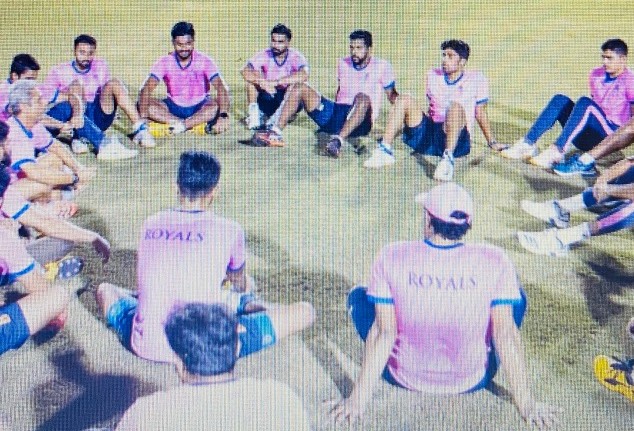Witnessing the IPL teams’ bio-bubble from a distance at the ICC Academy
By K.R. Nayar
I decided to drive down to the ICC Academy for
the first day’s IPL teams' practice session after they had completed their
quarantine period. It was a very different experience and I realised how tough
it was to pierce the bio-bubble. I returned home promising myself to never complain again about waiting for an interview with cricketers, since cricketers
in a bio-bubble cannot even be seen, forget meeting them in any way.

Rajasthan Royals at the ICC Academy during their first day's practice. Picture courtesy: Rajasthan Royals twitter
It is highly unlikely that anyone has ever seen or experienced a
bio-bubble. I witnessed what it would be like while waiting outside the bio-bubble
created for the IPL teams during my visit to the ICC Cricket Academy on
Wednesday evening when the Rajasthan Royals and Kings XI Punjab teams were having their practice session.
As journalists reporting on cricket, we've often
had to wait for hours to meet a player, and most of us are used to it. There
have been occasions when journalists are informed that a particular player will
be available for interaction before the start of their practice session, and
then suddenly plans change abruptly resulting in us having to wait till the end of
practice. Irrespective of whether the decision was made by the player or the
team, journalists have no choice but to wait till the player arrives.
Because if he is not available before practice, he will have to make himself
available at the end of the practice session. But Wednesday was a totally
different experience. So different that I doubt if I will ever complain about
waiting for a player again.
When a player is in a bio-bubble, no one is permitted to even enter the premises.
Right from the parking lot of the ICC Academy, all access to the inside of the
academy was blocked with railings. Only those familiar with the colour of
a team's jersey would be able to identify which team was training. Since
the Rajasthan Royals' sport a pink outfit, it was clearly visible under the
floodlights just like the pink ball, and I was able to spot them. Although
almost all top stars from limited over cricket have landed here, from the
permitted distance, even if you are a photographer with a zoom lens, it is
unlikely that anyone will be able to identify who are the players taking
catches at the ground during fielding practice.

Kings XI Punjab player at the ICC Academy nets. Picture courtesy: Kings XI Punjab twitter
Policemen and security in large numbers are spread all over and even
those working in the ICC Academy, who have been given a special badge,
were being allowed into the building only after the thermal scanner test.
A few youngsters who were hoping to capture a glimpse of the players were
waiting outside the railing, and they were shooed away by the bouncer-like
security staff. All of the security personnel were wearing a mask and
that made them look tougher. While these security men were positioned all
over close to the oval grounds, they were none near the path that players use to go to
the practice area.
An official from the ICC Academy spotted me and remarked: “Considering the heat
(around 40 degrees), all practice will be held in the evening. The practice
schedule for all teams has been prepared and distributed.” The ICC academy has
many practice nets and two oval grounds. From a schedule distributed to one of
the teams that I had access to, I noticed that areas to be used for practice
were clearly marked. If it was Oval 2 ground and three nets on one day, on
another day they were allocated half of Oval 1 and two nets. This meant that if
a team has been allocated a half field, they were supposed to do their fielding
practice only there. Practice dates at the Sharjah Cricket Stadium have
also been clearly mentioned for every team.
However, the authorities are yet to decide whether local media will be
permitted at least in a designated area and watch the practice sessions. My
visit to the Sharjah Stadium last week revealed that one cannot even pass
through the main entrance to the stadium without a thermal scanner test. In
fact, the security tests you right away while you drive through the gate.
At the ICC Academy, I saw a few sanitizing machines being carried into the
practice area. This machine was strapped onto a person's back, and I was told
that even kit bags and carry bags of players would be sanitized frequently.

Sanju Samson - a hit among Kerala fans
A few fans from Kerala were there hoping to get a glimpse of their state team
hero Sanju Samson who plays for Rajasthan Royals. Some of them had the
video of Sanju Samson entering his hotel in Dubai with flower petals being
showered all the way by the hotel authorities. They were only too happy to
share it with me. Matching their team jersey, the Rajasthan Royals players are
also sporting a pink mask. However, for those keen to watch the IPL players in
action, including journalists, it is a red light for now. Everyone
is hoping that it turns green soon.



Thanks KR for the insights you have given on how the government is taking severe precautions. Really nice to see the initiative of Dubai and sharjha government
ReplyDeleteOnly IPL name stays the same this season, rest for challenging reasons, everything, Timing, Weather, Situation, Playing Environment, Security, Players approach & as u have superbly pointed out even player’s proximity towards Media are all now a “catch me if u can” #Bubble world situation. Only hope the game is still the same, with Fun & good competitive cricket played around.😁. Txs for the first hand detailed info of Cricketer’s in a BUBBLE World...
ReplyDelete